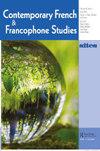Les ondes musicales de Michaël Ferrier
IF 0.2
4区 文学
0 LITERATURE, ROMANCE
引用次数: 0
Abstract
AbstractThe waves invade the work of Michaël Ferrier. They propagate there in all their forms, whether seismic, acoustic, electromagnetic (radioactivity), mechanical (wave) or gravitational. The waves go so far as to settle at the very heart of the act of writing to establish themselves as a principle. So, Ferrier transcribes them like a seismograph would, with the avowed objective of leaving a trace of memory and fighting against oblivion. Because a seismogram requires the eye of the technician to be deciphered, the writer adapts his text and chooses a medium that is more immediately and sensibly accessible. The music, itself propagating waves, will make the transcribed vibrations perceptible to the reader. This article reveals the means used by Ferrier to construct a musical text, and shows how this new composition of the text allows the writer to anchor it even more in the memories.Keywords: Disasterwavesseismographmusicmemoryreveal Additional informationNotes on contributorsAlexis L. ChauchoisAlexis L. Chauchois is an Assistant Professor of French at Mercer University. His interests span the 20th and 21st centuries, with a specialization in French & Francophone literature. He has been a Professor in Civil Engineering in France for several years.Gilles GlacetGilles Glacet received his Ph.D. from Emory University with a specialization in twentieth-century French literature. His areas of interest include nineteenth- and twentieth-century French literature, contemporary French literature and culture, as well as Francophone literature.michael Ferrier的音乐浪潮
摘要:波浪干扰了Michaël Ferrier的工作。它们以各种形式在那里传播,无论是地震、声波、电磁(放射性)、机械(波)还是引力。这股浪潮已经深入到写作行为的核心,并将自己确立为一种原则。因此,费瑞厄就像一台地震仪一样把它们记录下来,他公开宣称自己的目的是留下记忆的痕迹,与遗忘作斗争。因为地震图需要技术人员的眼睛才能破译,所以作者修改了他的文字,选择了一种更直接、更容易理解的媒介。音乐本身传播波,将使读者能察觉到转录的振动。本文揭示了费里尔构建音乐文本的方法,并展示了这种新的文本构成如何使作者更深入地将其固定在记忆中。关键词:灾害波地震音乐记忆揭示附加信息作者说明alexis L. Chauchois是美世大学法语助理教授。他的兴趣跨越20世纪和21世纪,专攻法语和法语文学。他在法国当土木工程教授已经好几年了。Gilles Glacet在埃默里大学获得博士学位,主修二十世纪法国文学。他感兴趣的领域包括十九世纪和二十世纪的法国文学,当代法国文学和文化,以及法语文学。
本文章由计算机程序翻译,如有差异,请以英文原文为准。
求助全文
约1分钟内获得全文
求助全文
来源期刊

Contemporary French and Francophone Studies
LITERATURE, ROMANCE-
CiteScore
0.30
自引率
0.00%
发文量
43
期刊介绍:
An established journal of reference inviting all critical approaches on the latest debates and issues in the field, Contemporary French & Francophone Studies (formerly known as SITES) provides a forum not only for academics, but for novelists, poets, artists, journalists, and filmmakers as well. In addition to its focus on French and Francophone studies, one of the journal"s primary objectives is to reflect the interdisciplinary direction taken by the field and by the humanities and the arts in general. CF&FS is published five times per year, with four issues devoted to particular themes, and a fifth issue, “The Open Issue” welcoming non-thematic contributions.
 求助内容:
求助内容: 应助结果提醒方式:
应助结果提醒方式:


